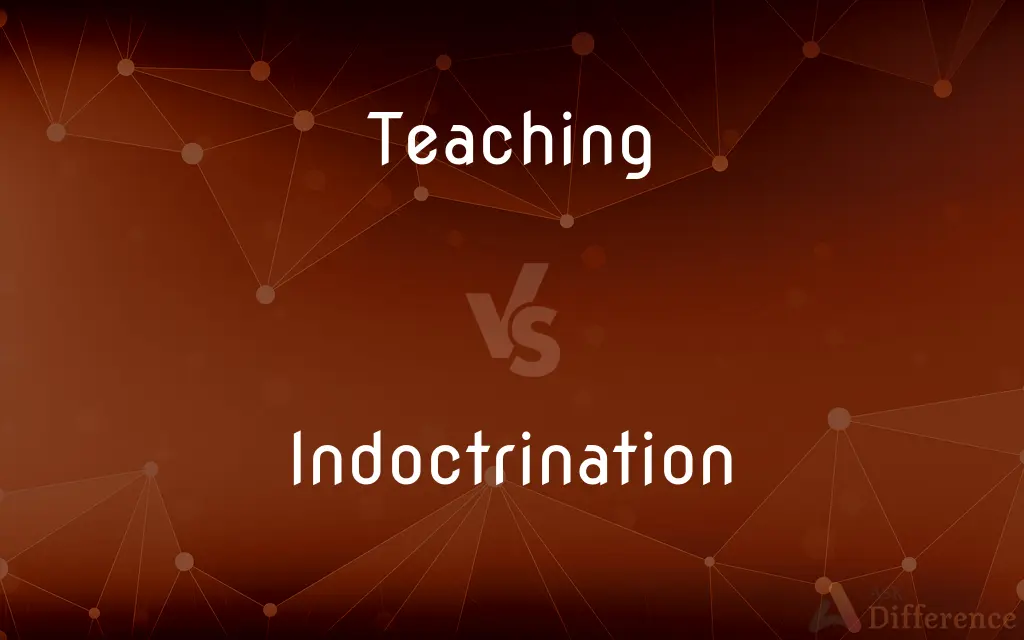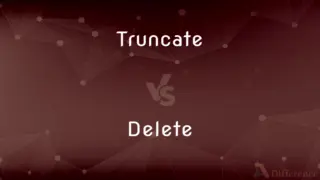Teaching vs. Indoctrination — What's the Difference?
By Tayyaba Rehman — Updated on October 30, 2023
Teaching involves imparting knowledge or skills, encouraging critical thinking; indoctrination imposes beliefs uncritically, often suppressing dissent.

Difference Between Teaching and Indoctrination
Table of Contents
ADVERTISEMENT
Key Differences
Teaching is the process of imparting knowledge, skills, or values, often in a structured environment like a classroom. It encourages inquiry and critical thinking. Indoctrination, in contrast, involves instilling a set of beliefs in someone, often without encouraging questioning or critical analysis.
A key element of teaching is fostering an environment where students can explore different perspectives. Indoctrination, however, often promotes a singular perspective, discouraging divergence from established beliefs or doctrines.
Teaching often involves a dynamic interaction between the teacher and the students, where feedback and discussions are integral. Indoctrination tends to be a one-way process, where the indoctrinator imparts beliefs with little room for dialogue or dissent.
In teaching, the goal is usually to develop a student’s abilities to think independently and form their own opinions. Indoctrination aims to shape a person’s beliefs to conform to a specific ideology, often discouraging independent thought.
The methods used in teaching can vary, including interactive, experiential, and inquiry-based learning. Indoctrination methods are typically repetitive and assertive, emphasizing rote learning and acceptance rather than understanding.
ADVERTISEMENT
Comparison Chart
Objective
Impart knowledge, encourage critical thinking
Impose beliefs, often discourage questioning
Environment
Encourages exploration of perspectives
Promotes a singular perspective
Interaction
Dynamic, with feedback and discussion
One-way, with little room for dialogue
Goal
Develop independent thinking
Shape beliefs to conform to an ideology
Methods
Interactive, experiential, inquiry-based
Repetitive, assertive, emphasis on rote learning
Compare with Definitions
Teaching
The act of guiding someone’s learning.
Teaching young children requires patience.
Indoctrination
Imposing a doctrine or ideology without encouraging questioning.
Indoctrination often suppresses independent thought.
Teaching
The dissemination of ideas or principles.
The philosopher's teachings influenced many.
Indoctrination
The process of teaching someone to accept beliefs uncritically.
The regime used indoctrination to control citizens.
Teaching
The act of imparting knowledge or skills.
Her passion for teaching inspired many students.
Indoctrination
The process of inculcating a one-sided belief system.
Indoctrination can occur in authoritarian regimes.
Teaching
The method or practice of instructing.
His innovative teaching methods were effective.
Indoctrination
Indoctrination is the process of inculcating a person with ideas, attitudes, cognitive strategies or professional methodologies (see doctrine).Humans are a social animal species inescapably shaped by cultural context, and thus some degree of indoctrination is implicit in the parent–child relationship, and has an essential function in forming stable communities of shared values. The precise boundary between education and indoctrination often lies in the eye of the beholder.
Teaching
The act, practice, occupation, or profession of a teacher.
Indoctrination
To instruct in a body of doctrine or principles.
Teaching
Something taught.
Indoctrination
To imbue with a partisan or ideological point of view
Children who had been indoctrinated against their parents' values.
Teaching
Often teachings A precept or doctrine
The teachings of Buddha.
Indoctrination
The act of indoctrinating, or the condition of being indoctrinated
Teaching
Of, involving, or used for teaching
Teaching materials.
Teaching methods.
Indoctrination
Instruction in the rudiments and principles of any science or belief system; information.
Teaching
Working as a teacher or in teaching
Teaching assistants.
Indoctrination
The act of indoctrinating, or the condition of being indoctrinated; instruction in the rudiments and principles of any science or system of belief; information.
Teaching
Something taught by a religious or philosophical authority.
Many follow the teachings of Confucius.
Indoctrination
Teaching someone to accept doctrines uncritically
Teaching
The profession of educating people; the activity that a teacher does when he/she teaches.
Teaching has seen continual changes over the past decades.
I have found a teaching job.
A teaching assistant
Indoctrination
The act of instilling a particular set of beliefs.
The cult's indoctrination was intense.
Teaching
Present participle of teach
Indoctrination
Teaching someone to accept a set of beliefs without criticism.
Her talk on critical thinking countered indoctrination.
Teaching
The act or business of instructing; also, that which is taught; instruction.
Teaching
The profession of a teacher;
He prepared for teaching while still in college
Pedagogy is recognized as an important profession
Teaching
A doctrine that is taught;
The teachings of religion
He believed all the Christian precepts
Teaching
The activities of educating or instructing or teaching; activities that impart knowledge or skill;
He received no formal education
Our instruction was carefully programmed
Good teaching is seldom rewarded
Teaching
The profession of educating people.
Teaching is both challenging and rewarding.
Common Curiosities
What is the primary goal of teaching?
The primary goal of teaching is to impart knowledge and encourage critical thinking.
What is the main objective of indoctrination?
The main objective of indoctrination is to impose a set of beliefs, often uncritically.
Is indoctrination a two-way interactive process?
No, indoctrination is generally a one-way process with little dialogue.
What methods are commonly used in teaching?
Teaching methods include interactive, experiential, and inquiry-based learning.
Does teaching encourage questioning and exploration?
Yes, teaching typically encourages questioning and exploration of different perspectives.
Can teaching be the dissemination of ideas?
Yes, teaching can involve the dissemination of ideas or principles.
What kind of interaction is involved in teaching?
Teaching involves dynamic interaction, including feedback and discussions.
Can teaching develop independent thinking in students?
Yes, teaching aims to develop students’ abilities to think independently.
Does indoctrination allow for critical analysis and dissent?
No, indoctrination often discourages critical analysis and suppresses dissent.
Does indoctrination encourage independent thought?
No, indoctrination discourages independent thought, aiming to shape beliefs.
Does indoctrination involve teaching to accept beliefs without criticism?
Yes, indoctrination involves teaching to accept beliefs uncritically.
Can teaching and indoctrination occur simultaneously?
While they have different objectives, elements of both can sometimes be present in an educational setting.
Are repetitive and assertive methods characteristic of indoctrination?
Yes, indoctrination often uses repetitive and assertive methods.
Is indoctrination associated with authoritarian regimes?
Indoctrination can occur in authoritarian regimes, though it's not exclusive to them.
Is teaching a profession?
Yes, teaching is a profession focused on educating people.
Share Your Discovery

Previous Comparison
Truncate vs. Delete
Next Comparison
Pinder vs. PeanutAuthor Spotlight
Written by
Tayyaba RehmanTayyaba Rehman is a distinguished writer, currently serving as a primary contributor to askdifference.com. As a researcher in semantics and etymology, Tayyaba's passion for the complexity of languages and their distinctions has found a perfect home on the platform. Tayyaba delves into the intricacies of language, distinguishing between commonly confused words and phrases, thereby providing clarity for readers worldwide.














































